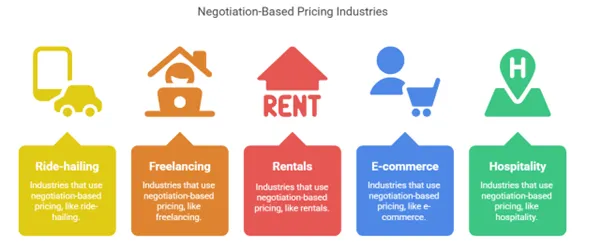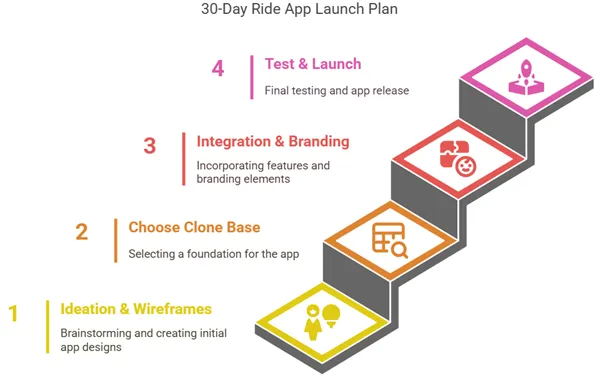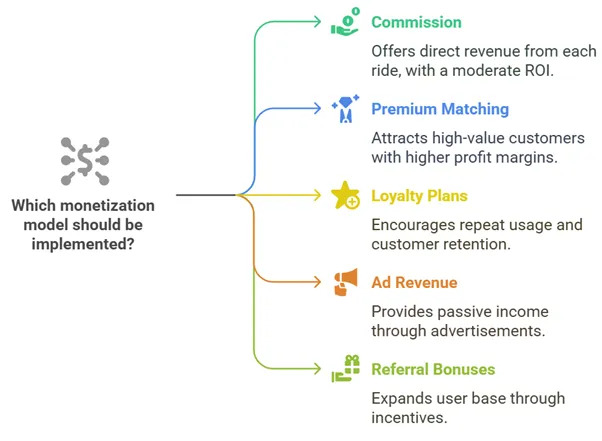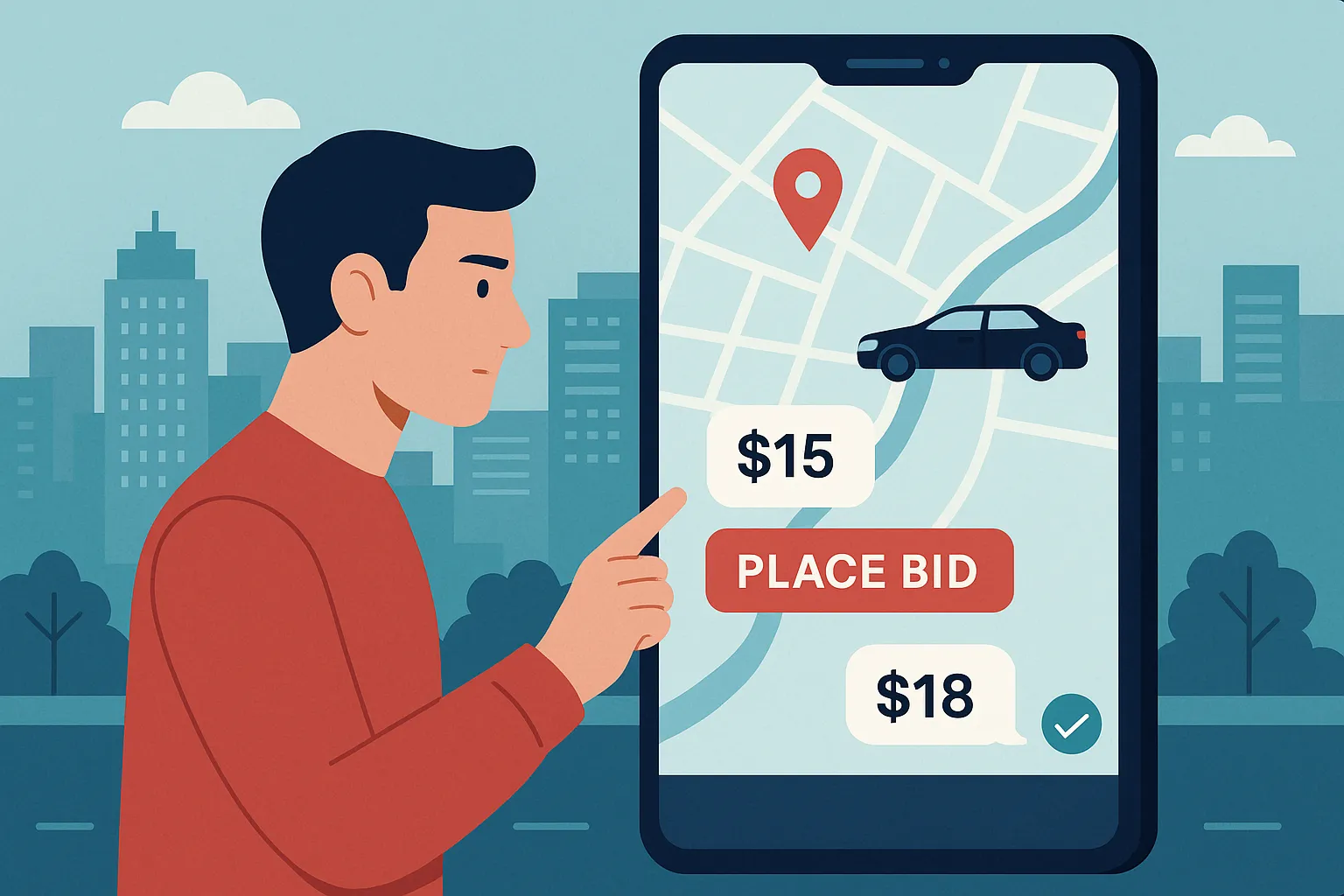So, you’ve got this idea — a ride-hailing app that doesn’t just connect riders and drivers, but actually lets them negotiate the fare. A little like haggling at your favorite flea market but with geolocation, real-time bids, and…well, better UX. But then the doubts creep in: “Can I really build this in 30 days?” “Will people even use it?” “What about ROI?” We get it — launching a new app idea feels like a leap off a cliff, even with a parachute made of spreadsheets.
Here’s the thing: the ride-hailing market isn’t slowing down — it’s evolving. Users want more power, more control, and more options. Uber and Lyft set the stage, but now it’s the era of localized innovation, where features like price negotiation, multilingual support, and loyalty bonuses can define your success. Think of it as turning your startup into the “Moj” of ride apps — nimble, culturally relevant, and seriously sticky.
Whether you’re a first-time founder or a serial entrepreneur, this post will walk you through how to launch a negotiation-based ride app in just 30 days. We’ll unpack the strategy, the tech, the user psychology, and why a demo-driven, ROI-focused, retention-ready approach is your secret weapon. And yep, Miracuves is right here, powering the engine behind your vision.
Why Negotiation-Based Ride Apps Are the Next Disruption
Consumer Behavior Is Shifting
The modern user isn’t just looking for a ride — they’re looking for control. People are tired of surge pricing and arbitrary algorithms. A negotiation-based model flips the script: riders propose a price, drivers respond, and both walk away satisfied (or counteroffer).
Local Needs Demand Local Solutions
In emerging markets like Southeast Asia, Africa, and Latin America, fixed pricing often doesn’t reflect real-time conditions. A ride from downtown to the airport during rush hour? It’s a negotiation waiting to happen. And platforms like InDriver are proving there’s huge demand for this model.

The 30-Day Launch Blueprint: What It Really Takes
Week 1: Ideation + Wireframes
Skip the fancy business plans. Instead, define your core journey:
- Rider requests a ride
- Inputs preferred fare
- Gets driver offers
- Accepts, counteroffers, or cancels
Create wireframes in tools like Figma, focusing on:
- Fare input UX
- Counteroffer UI
- Ratings with reasons (to build future trust)
Week 2: Choose Your Clone Base
Why reinvent the wheel? Start with a white-label ride app clone and customize:
- Use Miracuves’ InDriver clone or Uber-like architecture
- Add modules: in-app chat, real-time price updates, geo-fencing
What to look for:
- API-ready backend
- Modular pricing engine
- Push notification flexibility
- Native iOS/Android support
Week 3: Integration + Branding
This is where things heat up:
- Plug in Firebase or AWS for real-time sync
- Integrate payment gateways that support escrow logic (Stripe Connect, Razorpay)
- Add chat functionality (Twilio, Sendbird)
- Customize brand colors, splash screens, onboarding flows
Focus on first impression retention: Your app must look like it belongs on the user’s smartphone — not a prototype.
Week 4: Test, Launch, Tweak
This isn’t “build and vanish.” In Week 4:
- Run a 7-day internal test with 10–20 local drivers/riders
- Collect feedback on price accuracy, UI speed, and fairness perception
- Roll out public beta in one region or city
- Set up Mixpanel or Firebase Analytics to track drop-offs, offer acceptances

Features That Maximize Retention & ROI
1. Dynamic Fare Range Suggestions
Users aren’t economists. Help them decide what’s a “reasonable” fare based on:
- Distance
- Traffic
- Time of day
- Local ride history
Tech Stack Tip: Use ML-powered dynamic pricing APIs or start with rule-based logic.
2. Loyalty Perks (But Smart)
Ditch generic points. Instead:
- Riders get tokens for fair offers
- Drivers get badges for fast acceptances
- Tokens = discounts, top driver access, early matching
3. “Smart Haggler” Mode
Let users automate their price response:
- “Always auto-accept if price difference < $0.50”
- “Auto-send counter 10% below first offer”
This makes negotiation less manual and more delightful.
4. Split Fare + Group Negotiation
Uber didn’t go here, but you can. Allow groups to:
- Propose a joint fare
- Negotiate once for all
- Split the final bill automatically
Great for college towns and event-based travel.
Monetization Models That Actually Work
Commission + Premium Matching
- 10% from every successful ride
- Extra $0.25 for priority matching
- $2.99/month “Negotiator Pro” plan for auto-bargain tools
Ad Revenue (Hyperlocal)
Let local businesses advertise discounts for app users:
- “Show your ride receipt at Joe’s Café — get 15% off”
- Geo-fenced ad offers = high CTR
Referral Multipliers
Grow virally by offering:
- Rider-to-driver referrals
- Driver-to-driver incentives
- Weekly challenges for power users

Real-World Scenarios: How It Helps
- The Budget-Conscious Rider: Rahul from Mumbai doesn’t want to pay surge prices. He enters ₹100, gets 3 offers, picks the one closest, saves ₹30.
- The Strategic Driver: Fatima in Cairo prefers morning rides. She quickly accepts early offers, builds reputation, gets prioritized later.
- The Weekend Event Hustle: Groups leaving concerts use group haggle mode, making 5 trips easier to coordinate and cheaper overall.
Conclusion
Launching a negotiation-based ride app in 30 days sounds wild — but it’s wildly possible. When you combine hyperlocal insight with powerful pre-built tech, the result isn’t just a functioning app. It’s a user-loved, retention-primed platform ready for real-world chaos. Plus, the upside? You’re not just building a clone. You’re building agency into the ride-hailing experience.
At Miracuves, we help innovators launch high-performance app clones that are fast, scalable, and monetization-ready. Ready to turn your idea into reality? Let’s build together.
FAQs
1. What exactly is a negotiation-based ride app?
It lets riders propose a fare and drivers respond with acceptance or a counteroffer — giving both parties flexibility and fairness.
2. Can I really launch this in 30 days?
Yes! With a white-label base like Miracuves’ InDriver Clone, the heavy lifting is already done. You focus on customization and user testing.
3. Do users really want to negotiate?
In emerging markets and during peak hours, yes! Studies show users prefer price control over unpredictable surge algorithms.
4. What about legal and compliance?
That depends on your region. Most countries allow dynamic pricing but require tax transparency and insurance — make that part of your onboarding legal check.
5. How do I retain users in such a dynamic system?
Offer smart automation (like “auto-accept”) and gamified loyalty to simplify negotiation fatigue while keeping flexibility.








